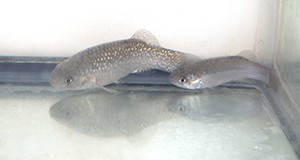Aquaculturists worldwide use artificial or induced spawning of fish to maximize egg and larval production from fish that cannot normally be bred in captivity. Despite the wide global use of this technique, and much literature published, the success rates of induced spawning are consistently variable. One often overlooked reason for the variable success rates is that successful rates of fertilization, hatching, and larval survival are most dependent on high-quality sperm and the surrounding fluid that supports sperm function. It is difficult to obtain consistent, good-quality spermiations (releases of spermatozoa); to keep sperm alive after collection and during storage and transport; and to freeze large volumes of semen at one time. Therefore, a successful fish breeding program requiring sperm begins with a source of high-quality semen, and its proper collection, handling, and storage. This three-page article written by Frank A. Chapman and published by the Program in Fisheries and Aquatic Sciences in the School of Forest Resources and Conservation describes how to make and use a semen extender that will maximize the volume and preserve the viability of obtained semen.
http://edis.ifas.ufl.edu/fa193
Tag: fish reproduction
FA154/FA154 Sturgeon Aquaculture – Specialized Techniques: Determining the Stage of Sexual Maturity in Female Sturgeon for Artificial Spawning: The Egg Maturation Assay
FA-153, a 4-page illustrated fact sheet by Frank A. Chapman and Joel P. Van Eenennaam, describes a biological test to determine if sturgeon eggs are in the stage of final maturation — the principle behind the test, materials needed, and protocol. Published by the UF Department of Fisheries and Aquatic Sciences, December 2007.
http://edis.ifas.ufl.edu/FA154
FA153/FA153 Sturgeon Aquaculture – Specialized Techniques: Determining the Stage of Sexual Maturity in Female Sturgeon for Artificial Spawning: The Egg Polarization Index or PI
FA-153, a 5-page illustrated fact sheet by Frank A. Chapman and Joel P. Van Eenennaam, describes a simple field and laboratory test used to assist in predicting ovulatory response in female sturgeon, which uses the egg size and position of the nucleus in the cytoplasm as indicators — the principle behind it, materials needed, biopsy procedure, and how to determine the egg polarization index. Published by the UF Department of Fisheries and Aquatic Sciences, December 2007.
http://edis.ifas.ufl.edu/FA153
